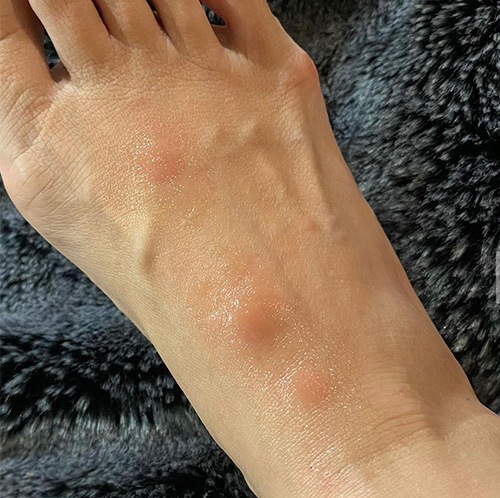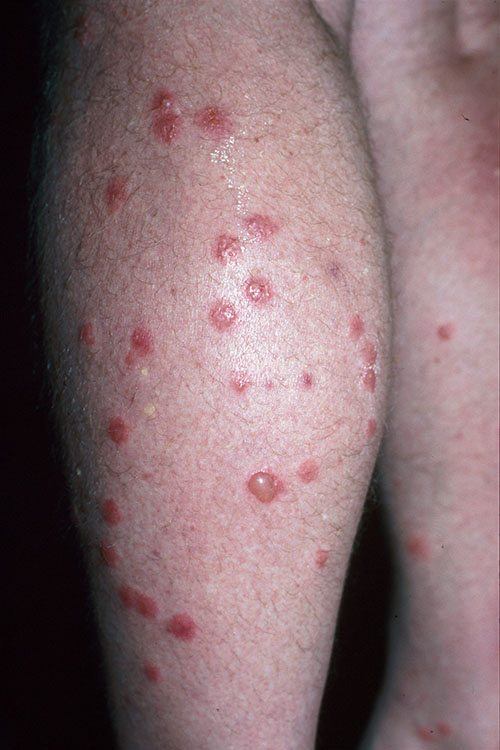Papular urticaria
If anaphylaxis to an insect bite occurs, treat immediately with adrenaline (epinephrine)—see advice on anaphylaxis.
Papular urticaria is a hypersensitivity reaction to insect bites, most commonly to mosquito or flea bites. It can occur at any age, but is most common in children aged 2 to 6 years. A fixed urticarial wheal (often with central vesiculation) develops within hours of the bite. Itch is intense, and scratching often leads to excoriation, infection and ulceration. Lesions often appear on exposed areas of the face, forearms and lower legs, but occasionally lesions develop on covered sites. Lesions are often clustered. New bites often reactivate old lesions, particularly in children (who can have persistent bite reactions, sometimes for months or years). See here for a photo of papular urticaria.
Preventing bites is the key to management; see preventive strategies in the Wilderness guidelines. Maintain these strategies throughout spring and summer when seasonal insects (eg mosquitos) are more prevalent.
Treatment of papular urticaria includes antipruritics and corticosteroids, as for insect bites. Unlike true urticaria, antihistamines are not as effective in papular urticaria, although sedating antihistamines may be used in patients with disturbed sleep associated with itching. For doses of sedating antihistamines, see here.
Reactions to bites from animal or bird mites can cause papular urticaria. These reactions are uncommon, but do occur in areas where people have close contact with animals. People come in contact with bird mites in hay (from chickens), or gutters and roofing (from pigeons). Rarely, they occur after contact with pets (eg dogs, cats, rabbits). The clinical presentation can mimic scabies, but typical burrows are absent. The rash is caused by an allergic reaction to the mite bites—it is not an infestation. Antiscabetic treatment is ineffective. Use a topical corticosteroid, as for insect bites, to relieve the itch and treat the rash. To prevent further rash, avoid contact with animals or birds, or treat the animal(s) with an appropriate insecticide (if possible).
Reactions to bites from bed bugs (Cimex lectularius or Cimex hemipterus) can cause papular urticaria. Bed bugs are small, oval wingless insects that feed on human blood (generally at night). They hide and lay eggs in household objects such as mattresses, sleeping bags, bedding, bed frames, furniture, carpet, skirting boards, cracks in plaster). Bed bugs can also hide in luggage and clothing, and are most often found in accommodation with high rates of occupant turnover such as hotels, motels, hostels, shelters and apartment complexes.
Bed bugs bite on exposed skin, usually the arms and shoulders, which can result in swelling and itching. Treatment of bed bug bites includes:
- using antipruritic creams (eg calamine lotion) or antihistamines
- washing bites with antiseptic soap to reduce infection risk
- applying ice pack to relieve swelling
- pain relief, if symptoms are severe.
Some recommendations for bed bug infestations include:
- thoroughly washing, vacuuming and cleaning all surfaces and bedding
- washing bedding and clothing in hot water; dry clothes in a clothes dryer on hot setting
- vacuuming mattresses, sealing in dark plastic and leaving outside in hot sun for as long as possible
- steam cleaning carpets
- spraying common hiding spots with a surface pesticide registered to control bed bugs; do not treat bedding with pesticide
- obtaining advice from a pest control company.
For more information on management of bed bug infestations, see the Better Health Channel and Department of Health (Victoria) websites.
BetterHealth Channel, 2018Department of Health, 2021SA Health, 2021


